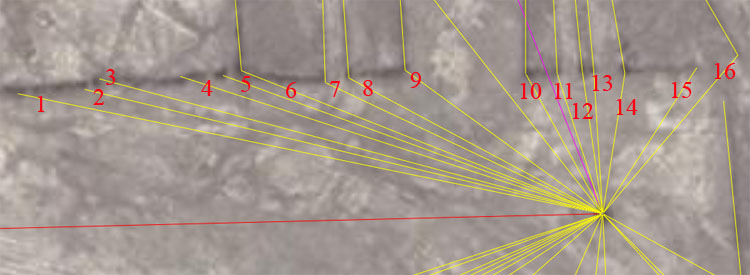
SO, LET'S IDENTIFY MORE CODES BRANCHING OFF THE EASTERN CAIRN

A selection of coded lines are seen to run to stations above the cairn, fanning from northwest to northeast.
1 The coded distance appears to have been 453.6-feet and the angle set to 101.376-degrees.
It's probable that this position was multi-coded and over a very small range carried other scientific information and tutorials in the closely related, marked lengths and angles. Position one is given as an example of one of the centralised markers that can be seen on the site. These interim markers look a bit like little earthen bridges and it's sometimes a a bit difficult to establish the precise point of resolution.
The 453.6-feet distance would code the vertical height of the Great Pyramid to the top of its altar floor. In all recorded history the pyramid was never seen to have a capstone. A calculation matrix design on its top would have been very useful for gathering scientific information about solar, lunar, planetary or stellar rises and sets around the horizon, using a large, swiveling alidade sighting rule over the expansive plane-table altar, which measured 44-feet square.
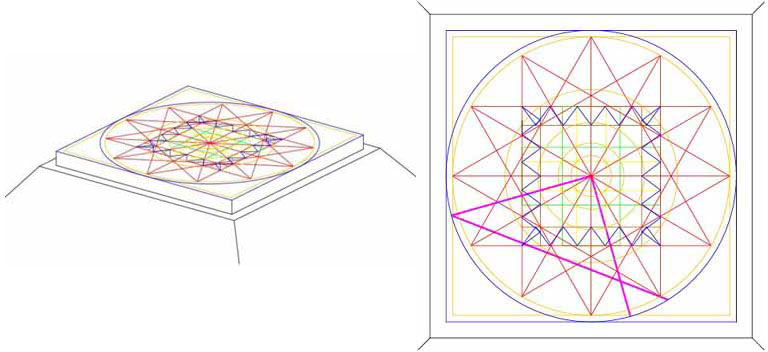
Based upon the geometric overlay system of star and cross patterns used by the ancient Celts and partially preserved by surviving groups with links to the ancient "Masters of the Craft", like the Masons, the calculation matrix atop the Great Pyramid should have looked approximately like this. A very similar matrix design is found in the hill country above Nazca and another variation on the design was incorporated into the Bush Barrow Lozenge of Southern England. A series of star and cross patterns are overlaid to form a 64-square matrix and this is the origin of our chessboard. The early-epoch zodiacs of Babylon and the Middle Eastern countries would also include a 12-pointed star to indicate the 12-houses of the Zodiac, spread 30-degrees apart around the ecliptic. In the picture to the right a special "purple" 3,4,5, triangle is included. As at Stonehenge, where the 56-posts of the Aubrey Circle acted as azimuth or angle stations and utilised a swiveling 3,4,5, triangle (using measuring ropes pulled between static post stations) of this sort to determine precise angles of stellar rise and set on the embankments, so also would the Great Pyramid's altar have, conceivably, functioned in a similar way. To see how the huge swiveling 3,4,5 triangle worked at Stonehenge to provide accurate degree angle fixes onto the alighting or rising positions of stars, CLICK HERE
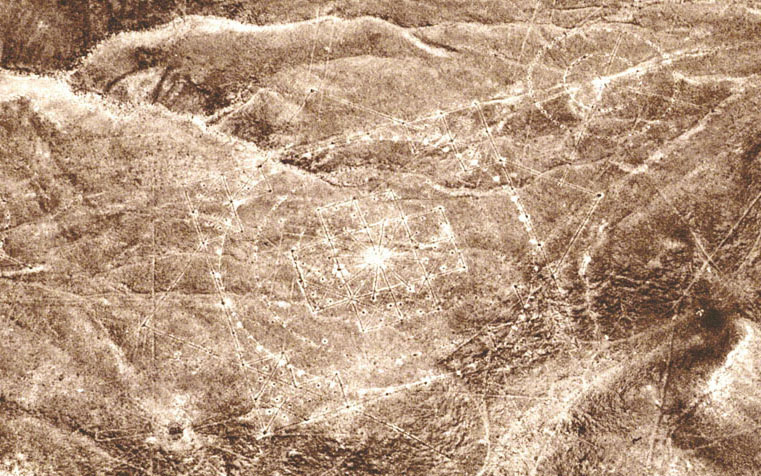
The calculation matrix etched into the ground in the hill country near Nazca above the desert geometry and glyphs. A very similar matrix is found to be purpose designed into the terrain at Rennes Le Chateau in Southern France. A full explanation of how star and cross patterns geometry forms the 64-square calculation centre is explained within this website. This design pattern constitutes a kind of "Holy of Holies", sacred-geometry for ancient European nations and anyone who understands the workings of each component part of the multi-layered geometry would be sufficiently adept to set up fully functioning and potentially abundant "CIVILISATION" anywhere in the world.
These matices, found around the
world, either as marked ground geometry or as zodiacal and memory-device artefacts,
varied somewhat in the codes that they contained. At both Rennes Le Chateau
and Stonehenge the concentric "square & circle" aspects of the
geometry mostly reduced in size according to (essentially) the PHI ratio (1
to 1.6180339) for each inward layer, although "Z" Holes at Stonehenge
(132-feet diameter) was straight navigational coding.
At Stonehenge there is a marker on the "Avenue" indicating the edge
of a circle that has a diameter of 466. 56-feet (navigational coding), which
reduces by (essentially) PHI to the diameter of the Aubrey Circle (288-feet
diameter ... navigation), which reduces by PHI to the "Y" Holes Circle
(178.2-feet ... navigation), which reduces by PHI to the Sarsen Circle (110-feet
... navigation).
The Nazca matrix, by consequence, contains 4 concentric circles, each coding
mostly navigational numbers, but with one strong lunar code represented by the
2nd inward circle (see explanation accompanying the gyph picture below).
As stated, the return angle from position 1 to the cairn surveying station is visually set to 101.376-degrees (1013 & 19/25ths ÷ 10). The stybolite platform upon which the Parthenon of Athens sits has an intended design width of 101.376-feet to represent 1-second of arc for an earth equatorial circumference of 24883.2 British Standard Miles of 5280-feet each. Alternatively, an angle of 101.25 would also be very significant to both lunar and navigational calculations. There would be 3.5 periods of 101.25-days in a lunar year of 354.375-days and 101.25-feet would be 1/7th the design length of the Khafre Pyramid (Egypt's Pyramid of the Moon).
2. The length from the cairn to this marked station is 405-feet at an angle of 283.5-degrees.
In both distance and angle the coding is primarily lunar. In the Sabbatical Calendar count of the Moon's period of 7.2-lunar years (2551.5-days) there would be 63 intervals of 40.5-days (972-hours). In the 25920-year count for the duration of the Precession of the Equinoxes there would be 64-periods of 405-years. The perimeter value of the Khafre Pyramid (2835-feet) equates to 405-feet X 7. There would be 8.75 intervals of 40.5-days in a lunar year.
The angle of 283.5-degrees from the cairn to this station is self-explanatory. The sum of 2835-days is 8 lunar years and 2835-feet was the design perimeter value for one circumnavigation of the Khafre Pyramid. It was also a carefully marked design-length within the Octagon geometric earthmound complex of Newark Ohio.
3. The distance is 396-feet at an angle from the outer-marker station back to the cairn of 105-degrees.
The 396 value is a part of a mathematical progression that relates to the equatorial circumference of the Earth, as measured by the mile of 5280 ("11" family of numbers). The progression goes: 396, 792 (the Earth is, quite literally, 7920 British miles in diameter), etc.
The angle codes the value for the Hebrew Reed measurement of 10.5-feet (10-Greek feet of 12.6-inches each or 5 Assyrian cubits) The Great Pyramid @ 756-feet long is 72-Reeds in length. The Greek mile of 5250-feet is 500-Reeds and the Greek stadia of 630 feet is 60-Reeds. There would be 243 intervals of 10.5-days (252-hours) in the Sabbatical Calendar lunar count of 2551.5-days. There would be 243.5 intervals of 10.5-days in the Sabbatical Calendar solar count of 2556.75-days (7 solar years). There would be 270 increments of 10.5-feet in one circumnavigation of the Khafre Pyramid, etc.
4. The distance is 337.5-feet @ 108-degrees return to the cairn.
A mathematical progression based upon 337.5 is primarily lunar, but the values derived are also very useful for navigation. There would be 756 intervals of 33.75-days in the 2551.5-day (7.2 lunar year) count of the moon within the Sabbatical Calendar.
The angle in this instance (108-degrees) renders a value that was very important to navigation, the lunar period, the Precession of the Equinoxes count and the equatorial size of the Earth. The progression goes: 108, 216 (note that under the 25920-year duration of Precession the sun spends 2160-years in each house of the zodiac... the British bushel was 2160 cubic inches, the Babylonian Homer was 21600 cubic inches, the Hebrew Desert Standard Log was 21.6-cubic inches, the moon is 2160-miles in diameter), 324, 432 (the Great Pyramid is 432 Celtic cubits of 21-inches each in length), 540 (multi-purpose value of immense importance and especially for lunar counts), 648, 756 (length in feet of the Great Pyramid... 1/8th of 1-second of Earth Equatorial arc), etc.
5. The distance is 307.2-feet at an angle of 110-degrees.
The 307.2 constituted a part of a navigational mathematical progression, based on using the value 24883.2-miles (Greek or British) to describe the equatorial circumference. Amongst the values that occur using this progression is 101376. Remember that the stybolite platform of the Parthenon is 101.376 feet wide and that this represents 1-second of arc for a world of 24883.2 British standard miles of 5280-feet each. There are 3072 Egyptian Royal Cubits of 20.625-inches each in a British Standard mile.
The angle of 110-degrees is part of an 11-family progression used in navigation by the ancient British and Germanic tribes. The British distance measures into modern times were divisible by 11. This includes: League (16500-feet), Mile (5280-feet), Furlong or furrowlong (660-feet), Chain (66-feet) Rod or Perch (16.5-feet), Fathom (originally 5.5-feet, but in recent centuries modified to 6-feet) & Link (7.92-inches). If the Great Pyramid @ 756-feet were symbolically elongated 3-inches to 756.25-feet, then this would comply perfectly to the British "11" navigational system. The wonderful mathematical window of opportunity offered is that any linear sea-legs completed in 11-series increments will provide a diameter that converts to a sexagesimal circumference using PI @ 314&2/11ths ÷ 100 (3.141818182). The Greeks used PI @ 22 ÷ 7 for their system of navigation (3.142857143 ...or 3 & 1/7th).
6. The distance to this very important corner position where a secondary line commences is 295.3125-feet (295 & 5/16ths-feet) and the angle from the cairn to this position is 291.6-degrees.
The distance is, of course, coding the duration of the lunar month at 29.53125-days. This length would be 1/2 the design length on the diagonal (hypotenuse) running up the faces of the Khafre Pyramid to its apex (590.625 feet) based upon the pyramid being built to the formula of a 3.4.5-triangle. The dimensions are: (adj.) 354.375-feet...1/2 the base length, (opp. 472.5-feet)... height and (hyp.) 590.625-feet... diagonal. Sir William Flinders Petrie, in his assessment of the Khafre Pyramid, agreed it was built to the 3,4,5-triangle principle.
The angle (291.6-degrees) is both navigational and lunar in nature and also has a strong association to the Roman Pace (58.32-inches... 29.16-inches X 2) and foot (11.664-inches). The Bush Barrow Lozenge artefact of Southern England, used at Stonehenge, is 7.29-inches long or 1/8th of a Roman Pace. It dates to a time of perhaps 2000-years before there was a Roman Empire. All of the values used at Nazca can be traced back to the Pyramids of the Gizeh Plateau and Saqqara, long before the advent of Roman & Greek civilisations.
7. The distance is 233.28-feet (233.3333) at a return angle back to the cairn of 115.2-degrees.
This distance would be 240 Roman feet or 48-Paces (of course the Romans never invented the increment, only adopted it from earlier cousin civilisations at a very late era). The Roman measure introduces yet another navigational system for traversing the vast oceans. Under this system any linear diameter, using a Roman mile of 5000 Roman feet of 11.66666-inches each converts to a perfect "11" family value on the circumference of a circle, using PI @ 22/7ths. This window of mathematical opportunity could be exploited when doing positional plotting at sea to keep track of degree angles back to the point of departure or onwards to the destination. The Roman method was similar to the Greek method, whereas the British method converted an "11" family diameter into a sexagesimal circumference divisible by 360-degrees (Babylonian 360-degree method). The early cousin nations used a variety of systems to circumnavigate the world safely and set up either temporary mining operations or long term civilisations on several far-flung continents.
It's very obvious that there was considerable interaction and trade going on between Peru-Bolivia with ancient Egypt, inasmuch as there was widespread use of South American substances in Egypt ( Nicotine, Cocaine). The use of sedatives was widespread in ancient Egypt and the substances positively detected in ancient mummies also include Hashish, a Cannabis-Marijuana derivative from Asia. To see one article that shows the serious infighting in academic circles over the "unwanted find" of Nicotine & Cocaine in millennium's old Egyptians, thereby demolishing the classicist-isolationist religion, theoretical base and orthodox view concerning world history CLICK HERE
The angle in this instance is 115.2-degrees and this is a very important navigational value. The Sarsen Circle at Stonehenge was capped by 30 horizontal lying lintels, wherein the outer-rim sweep per lintel capstone averaged 11.52 feet, for a full circumference of 345.6-feet. A mathematical progression based upon 11.52 is very important to navigation. In viewing the equatorial size of the Earth as 12 X 12 X 12 X 12 X 1.2-miles or 24883.2-miles (either Greek of British), the sum of 115.2-miles would be 1/216th part. The actual surface area of the 4 faces of the Great Pyramid were 230400-square feet each (8-Egyptian acres) or 115200 X 2. Amongst its several uses, this very versatile value was also used to correct the Sothic year (365.25-days to the true duration of the year, by deducting 11.52-minutes from 365.25-days.
8. The distance is 218.75-feet at an angle of 118.125-degrees.
The distance value is a part of a mathematical progression that relates to lunar and navigational calculations. The progression goes: 218.75, 437.5, 656.25, 875 (at the end of the Sabbatical Calendar count in the Sabbatical year, there were 8.75-days of deficit error), 1093.75, 13125 (important navigational value), 1531.25, 1750 (very important navigational value... also used as a ratio (1.75) to convert seven-based fractions to whole numbers...eg... 360 ÷ 7 = 51.42857143 (X 1.75) = 90), 1968.75 (This value was used copiously in navigation. It also was used in both the Egyptian and Roman standards for weighing gold. In both instances the "Beqa" weight was 196.875-grains. The numbers found on the ground at Nazca were also the numbers used in all ancient Mediterranean and European Weights, Measures and Volumes.
The return angle back to the cairn surveying station is 118.125-degrees. This value in days represents 4 lunar months of 29.53125-days each. This value in feet represented the base value for creating the Khafre Pyramid under the geometric method of the 3,4,5 triangle. The sum of 3 X 118.125-feet (354.375-feet) represented half the base length or the "adjacent". The sum of 4 X 118.125-feet (472.5-feet) represented the vertical height or "opposite". The sum of 5 X 118.125 represented the face diagonal or "hypotenuse".
9. The distance is coded to be 185.625-feet (185 & 5/8ths) and the return angle to the cairn is 126-degrees.
The distance is part of a slightly more complex navigational progression, which is based upon the mile of 5280-feet. When the Roman Pace of 58.32 is divided by 18.5625 the result is 3.141818182, which is the PI value used in navigation to convert distances covered in miles of 5280 feet or leagues of 16500-feet (3.125-miles) into sexagesimal (divisible by 60) circumferences. Hence: 16500-feet X 3.141818182 = 51840-feet or 144-feet (12 X 12) per degree. The sum of 314.18181818 is 314 & 2/11ths.
The degree angle is an expression of the Greek foot (12.6-inches) and mile (5250-feet), as well as the Hebrew reed (10.5-feet), etc.
10. The distance to this corner position is 121.5-feet at an angle of 115.2-degrees.
The distance of 121.5-feet codes a value that was very important to the lunar cycle and navigation. The progression went: 121.5 (there would be 21 intervals of 121.5-days...which is 2916-hours... in the 2551.5-days that constituted the lunar count within the Sabbatical Calendar), 243, 364.5 (in days this lunar count was only .75 of a day off the solar year and ancient farmers were using a year count of 364-days until the "correction" festival at the end of the seventh or Sabbatical year), 486 (the half "reed" measurement was 5.25-feet and could be used as a calculator for keeping track of the positions of both the sun and the moon during the Sabbatical cycle. There were 486 intervals of 5.25-days in the 2551.5 lunar count and 487 intervals of 5.25-days in the 2556.75-day solar count. The length of the Celtic Calendar of Coligny of ancient France is 4.86-feet. The length of a Roman mile was 5000 Roman feet or 4860 British standard feet, etc.), 607.5, 729 (the length of the Bush Barrow Lozenge memory device of Southern England was 7.29-inches or 1/8th of a Roman Pace), 850.5 (navigation), 972 (navigation)...1944 (navigation), etc. This value is at the basis of one of the most important mathematical progressions of antiquity
The return angle to the cairn is 151.2-degrees. The Great Pyramid has a side length of 756-feet and the total for two sides is 1512-feet or 1/4th of one minute of Earth equatorial arc. The value relates primarily to navigation, but was also used for tracking the lunar period within the 6804-day lunar nutation cycle (major standstill to minor standstill and back to major standstill). There were 45 interval of 151.2-days (3628.8-hours) in the 6804-day cycle. It's worthy to note that one circumnavigation of the Great Pyramid (3024-feet) was 36288-inches for 1/2 a minute of Earth equatorial arc and that there were 362880-feet in 1-degree of arc according to the Great Pyramid's geodetic system. Under certain ancient mathematical systems in place, one finds the brilliant use of the same values to describe both lunar periods and principles of navigation simultaneously. The Greek system, supposedly acquired by them from the Egyptians, demonstrates this capacity perfectly.
11. The distance is 112-feet at a return angle to the cairn of 162-degrees.
The value 112 was very important within the Great Pyramid measurements and 27 X 112-feet would represent one circumnavigation of the Great Pyramid. It was a part of a mathematical progression that related to navigation. The Great Pyramid's value for 1-second of equatorial arc would be 100.8 feet and 11.2-feet would be 1/9th of that value. If the full equatorial circumference is given in feet then the Great Pyramid's value is 24883.2 X 5250 (Greek mile) = 130636800 British feet. This value divided by 1120 = 116640. It will be recalled that the Roman foot was 11.664-inches. If the 130636800-feet value was converted to Greek feet of 12.6-inches, then there would be 12441600 such feet in the equatorial circumference.The sum of 24883.2 is 124416 X 2. If the 130636800-feet value was converted to the larger of the Egyptian Royal Cubits (1.728-feet or 20.736-inches) then there would be 75600000 in the circumference of the Earth. If the 130636800-feet value was converted to Roman feet of 11.664-nches, there would be 134400000, etc. The known ancient measurement standards of all the cousin nations will dovetail into each other like this and are merely different ratio expressions of the selfsame mathematical parcel shared by all. With regards to the larger Egyptian Royal Cubit @ 1.728-feet, it is interesting to note that a British cubic foot (12 X 12 X 12-inches) = 1728 cubic inches.
An early Egyptian weights system was made up of the "Kite", "Deben" and "Sep". When King Henry VIII reformed the British weights system he essentially adopted this early Egyptian standard to replace yet another ancient standard in general use in England. The new standard was made up of of an ounce (10 Deben or 100 Kite) and 16 such ounces made 1 British pound. The sum of 112-pounds made 1-cwt (hundredweight) and 20 such cwt made 1-ton (2240-lbs). The former British measurement, volume and weight systems, that have recently been replaced by "metrickery", have roots in ancient Egypt from before 5000 BC.
The degree angle from this outer-marker station to the cairn is 162-degrees. This is coding "rounded PHI" @ 1.62 or pure PHI @ 1.6180339 (see explanation on PHI coding within the dimensions and angles of the Great Pyramid... above).
12. The distance is 108.864-feet (1088 & 13/20ths ÷ 10) and the return angle to the surveying cairn station is 171.875-degrees (171 & 7/8ths).
The distance codes a very important value in a navigational progression, which increases to the value 1306.368 in 12 steps. This is, of course, related to the Great Pyramid's standard for the equatorial circumference of the Earth (130636800-feet) and this length at Nazca would be 1/1200000th of the equatorial circumference. The value was also marginally exploitable for measuring intervals within the lunar nutation cycle of 6804-days. The position would have been dual coded to also mean 108-feet, a very important navigational increment.
The angle is 171.875-degrees and this was a very important value that related to the equatorial circumference of the Earth under the "11" system, with a mile of 5280-feet. Depending on the navigational system being used, the Egyptians had slightly different "Royal Cubits" of length. These were:

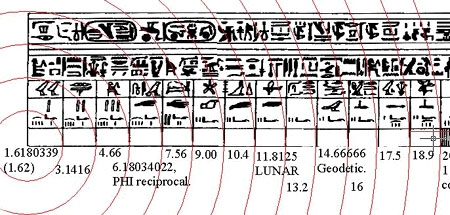
The segments of an Egyptian Royal Cubit of 20.618-inches
in length (as displayed at the Turin museum). The 1st interval is a PHI
inch (1-inch X 1.6180339); The 2nd interval is a PI-inch
(1-inch X 3.1416); The 3rd interval seems to be coded at 4.6656-inches (navigational
progression); The 4th interval is a special PHI reciprocal
value that was absolutely essential for the fabrication of correct (precise
capacity) round volume vessels for the ancient market places... for example:
the ancient British Bushel was a round tub with a base diameter of 3
X 6.18034-inches and straight sides above the base 8-inches high, giving
an exact capacity of 2160-cubic inches); The 5th interval is navigational (note:
the Great Pyramid is 756-feet long), etc.
The Royal Cubit layout seems to have been unsuitable as a rule used in building
work, but functioned more as a specialised calculator and memory device. Other,
more factorable, cubit or foot rules would have been used in construction work.
The return angle of 171.875-degrees to the cairn is in deference to the British-Celtic navigational system and the value of 1.71875-feet would be 20.625-inches.
As stated, the Nazca geometry was set out for the purpose of teaching initiates how to become navigators and astronomers and after several years of grueling training in this open air university the lessons would have been indelibly fixed in the mind of the student, ...so intense was the course of instruction.
13. The length is 108-feet and the angle from the cairn to this position is 356.4 degrees.
The length value was part of a mathematical progression that produced numbers useful in navigation, Precession of the Equinoxes calculations, the lunar period and the Sabbatical Calendar system.
The angle relates to navigation. Its half value, 178.2 (in feet) is the width of the "Y" Holes circle at Stonehenge. The value also features prominently in a PHI reduction of the circles at Stonehenge wherein the Aubrey Circle (288-feet) ÷ PHI (1.6180339) = the diameter of the "Y" Holes Circle (178.2) ÷ 1.6180339 = the diameter of the Sarsen Circle (110-feet).
The value is a part of the "11" family of numbers related to the equatorial size of the Earth in miles of 5280 feet. It is a value that occurs in a mathematical progression that goes: 39.6, 79.2, 118.8, 158.4, 198, 237.6, 277.2, 316.8, 356.4....950.4....990....1306.8....1900.8 (the Roman Amphora was 1900.8 cubic inches)....28512, etc. Some chosen values from this progression were incorporated into the ancient Hebrew Sepphoris Dry Volume standard, wherein a Log was 3.96 cubic inches, a Cab was 158.4 cubic inches, a Seah was 950.4 cubic inches, an Ephah was 2851.20 cubic inches and a Homer was 28512 cubic inches.
A very probable explanation for this value is that it represented a substitute value for 360-degrees in a compass when navigating at sea using the Greek "6&7" method. This is how it worked:
The essential element is that with an "11" based rule, accurate degree angles could be easily calculated and a mathematical system for precise positional plotting existed. It is interesting to note that the ancient German artefact, The Sky Disk of Nebra, is 1-Greek foot wide (12.6-inches), which converts to an outer ring circumference (using PI @ 22/7ths) of 39.6-inches or 360 X .11-inches. The Sky Disk even had 39-holes around the outer rim (to infer 39.6, in keeping with the circumference calculation based upon a diameter of 12.6-inches). The Vikings are known to have used a rule of 11-inches and the Saxon foot was 12 X 1.1-inches (13.2-inches) Many other ancient Scandinavian measurements comply to increments within the Greek (6&7) system for linear travel converting to an 11-based circumference.
14. Again, this distance appears to be 108-feet and the return angle to the cairn is 189-degrees.
The 108-feet distance is a dynamic navigational number, whereas the degree angle codes an increment of length within the base length of the Great Pyramid (756-feet long = 189-feet X 4).
The value 189 was very important within calculations of the ancient European cousin nations. The sum of 189-feet equated to 1/32nd of 1-minute of equatorial circumference arc under the Great Pyramid's literal system. The sum of 1890-days was a very important value within the lunisolar Calendar of Coligny of Celtic France. The large brass plaque offered either 64 full squares, 128 half squares alternating between 14 & 15-days, 60 named months in two parts and two CIALLOS or optional calculation sections for use as required. One had the option of using the Ciallos regions when calculating the duration of the 6804-day lunar cycle or for doing individual, customised counts (of various kinds) for the sun and moon. Otherwise, the repeats of 60 named months could unravel endlessly and the positions of both sun and moon within the Sabbatical Calendar tracked day-by-day. This, in part, is how it worked:
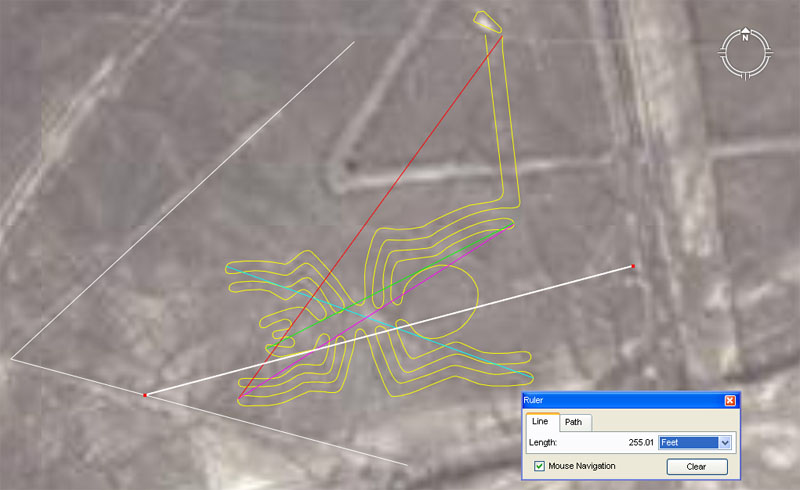
The Spider at Nazca moves along a line that is 255.15-feet long and which is set to the azimuth angle of 255.15-degrees* around from north. The white line shown covers a marked ground line at Nazca, indicating the orientation and path of travel for the spider. The coding is lunar and refers to the 2551.5-days (7.2-lunar years @ 354.375-days each) counted within the ancient 7-solar year Sabbatical calendar system. The long leg of the spider sits on an azimuth angle very close to 172.8-degrees around from north and the angle code is navigational. Here is a sampling of other tutorials associated with the spider:
These sample examples show how the glyphs were carefully fabricated to a mathematically conceived design plan that could be used in practical tutorials. Generations of initiate navigators and astronomers would have, over time, been assigned the task of deciphering the many, in-built, coded length & angle aspects of the spider. This tedious task would have been accomplished by making careful measurements and calculating precise angles, then recording all of the extracted codes for later redrafting. Undoubtedly, a small, scaled representation of the spider would then have been drawn on slate or some other markable surface by the students for close scrutiny by the tutor, who could then judge how well lessons had been learnt and principles understood.
Footnote: All of the special numbers encoded by lengths and angles at Nazca and other "open air universities" were also incorporated into the "standards" of length, volume and weight within individual European nations of antiquity. Even within a nation itself, there could be many different expressions of the "mile" from province to province, but all were in a direct ratio relationship to each other. It seems obvious that, at some ancient era, each province was assigned (by Druidic priests?) the responsibility to preserve particular numerical values found within the overall parcel of scientific numbers. Some provinces would be preserving "lunar" information, whereas others would be preserving navigational values directly proportional to the equatorial size of the Earth. Here's an example of early Germanic lengths, based upon the Flemish system, that were in use in the 13th century AD and prior. The values given in metres are taken from "official" or expert literature and show only very small drift off the original, precise increments of more remote antiquity.
ALT KULMISCHE MASZ
1 Meile = 1800 Ruten ... 7777.24 Metres (this equals 25515-feet to a tolerance of 10.5-inches in 4.86 Greek miles of 5250-feet each. It is very obvious that this ancient Germanic/ Flemish/ Prussian system was fully founded on, what's come to be known as, the Greek-mile system).
1 Rute = 15 Schuh ... 4.3218 Metres (the Rute, which was in direct ratio to the Meile, was 14.175-feet. The Khafre Pyramid of Egypt, which was a "pyramid of the moon" accentuating the lunar cycle periods, was 2835-feet in perimeter value or 200 Ruten).
1 Schuh = 0.28812 Metre (The Schuh, of which 15 made up 1-Rute, was .945-feet or 11.34-inches). This was the increment of length that Greek Historian Herodotus was told about by Egyptian priests, who stated that the Great Pyramid was 800-feet long ... Therefore: 756-feet ÷ 800 = 11.34-inches. By using a rule of this length, the Great Pyramid base perimeter could give lunar cycle readings. Three side lengths of the Great Pyramid @ 756-feet per side = 2268-feet or 1134-feet X 2. The Great Pyramid is 3200-Schuh in perimeter and the Khafre Pyramid is 3000-Schuh.
1 Elle = 2 Schuh 0.57624 Metre (The Elle was 22.68-inches and there would be 1200-Elle in three base side lengths of the Great Pyramid). Alternatively, the width of the Station Stone's Rectangle at Stonehenge was 113.4-feet or 60 Elle).
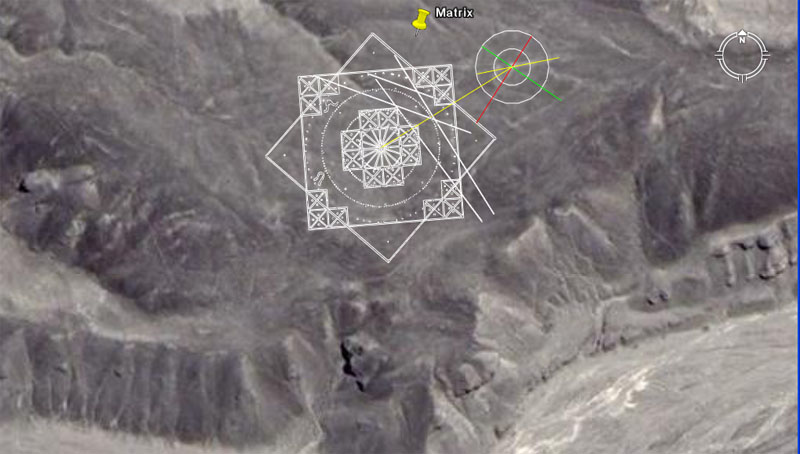
The elaborate calculation matrix in the Nazca hill country lies on a azimuth angle off north of 176-degrees (coding navigation by the 5280-feet mile).
15. The distance is 132-feet and the angle is 32.8125-degrees (32 & 13/16ths).
The 132 value is a part of a very important mathematical progression to do with the mile of 5280-feet and navigation by that standard. The progression goes: 132, 264, 396, 528 (1/10th of a mile in feet), 660 (1-furlong in feet), 792 (the Earth is literally 7920-miles in equatorial diameter), etc.
The ancient Celts are known to have had a "Saxon foot" of 13.2-inches or 12 X 1.1-inches. At Stonehenge, the "Z"-Holes circle is 132-feet in diameter (which is 76.8 Egyptian Royal Cubits of 20.625-inches).
The degree angle is part of a progression that relates to the cycle of the moon and also to navigation by the mile of 5250-feet. The progression goes: 32.8125, 65.625, 98.4375, 131.25 (much used lunar and navigational increment), ... 196.875 (the Egyptian and Roman gold standards for their "Beqa" weight were 196.875-grains, ...295.3125 (in days this would be 10 lunar months), etc. Remember, that all the decimal values seen above are only simple fractions, easily calculated on a manual abacus.
16. The length through the corner position to where the secondary line begins is 158.4-feet at an angle of 40.5-degrees from the cairn.
The value of 158.4 is part of an "11" family mathematical progression that relates to the mile of 5280-feet.
The angle of 40.5-degrees relates to a predominantly lunar mathematical progression. There would be 63 intervals (9 X 7) of 40.5 days in the 2551.5-day lunar duration monitored within the lunisolar Sabbatical Calendar system. There would be 168-intervals (24 X 7) of 40.5-days in the 6804-day lunar nutation cycle. There would be 640 intervals of 40.5-years in the 25920-year period of the Precession of the Equinoxes.